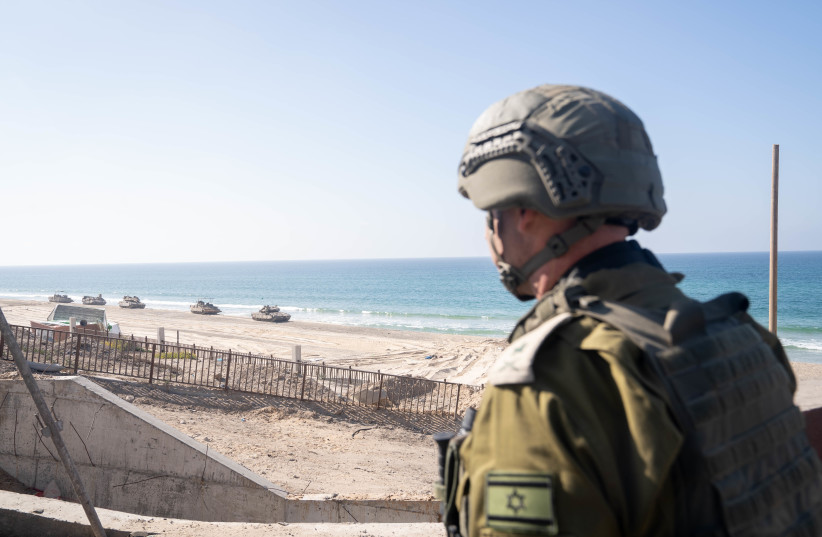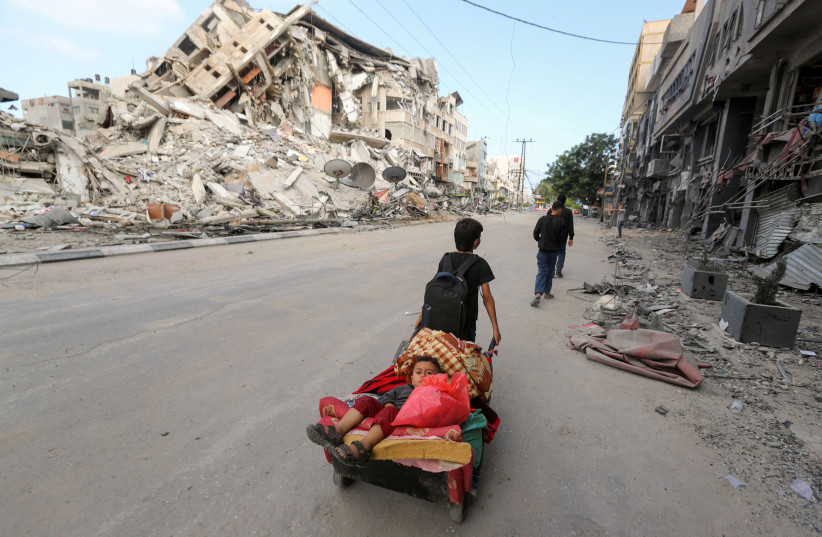It is better for the IDF to leave all these and focus on the very difficult fighting that is still expected in Gaza.
TAL LEV-RAM/MAARIV NOVEMBER 13, 2023 00:31

While the IDF is fighting in the Gaza Strip, Hezbollah is working to identify the weak points of Israel’s air defense systems. This means that during a war, the drone threat is expected to be significant for Israel on several fronts.
The IDF announces that the war in Gaza will last for many months, while the American administration begins to move uncomfortably and hints at a few weeks.
French President Emmanuel Macron criticized Israel for killing children and women in Gaza and announced that he supports a ceasefire – a line that the American administration may also adopt.
All this while in the background, according to foreign publications, negotiations are progressing for a deal to release 100 children and women.
In the Gaza Strip, the IDF continues to increase the pressure around the Shifa Hospital, which has become the symbol of the battle for the city. In the coming days, the fighting in the Gaza Strip is expected to expand to other areas.

At the same time, the escalation continues in the North, and the exchange of blows over the weekend between Israel and Hezbollah expresses a growing possibility of increasing the intensity of the direct confrontation between the two parties with the intent that it will lead to the expansion of the conflict (which mostly took place at a depth of a few kilometers on both sides of the border).
Hezbollah’s announcement at the end of last week that as a result of the airstrikes in Syria seven of its operatives were killed, is to a large extent a form of taking indirect responsibility for the launch of the suicide drone that hit the Tzeelim school in Eilat.
This came after the IDF announced that they attacked the group responsible for launching the drone toward Israel’s Sunshine City.
Even if the Iranian Imam Hussein Brigade is involved in the operation, Hezbollah likely wanted to take sole responsibility for it. The launching of the three drones together towards Israel last weekend also expresses a trend of escalation.
Besides the drone that exploded on a military post and severely wounded an IDF soldier, one of the drones exploded in the Galilee Panhandle – this is in addition to the fact that Hezbollah also continues to launch the short-range Burkan rockets with a warhead of hundreds of kilograms, up to half a ton.
Seizing the advantage
On the other hand, the Air Force also took advantage of opportunities. After Hezbollah’s attempts to fire air defense missiles at Air Force drones, a truck from which the missiles were launched was attacked in the Zahrani River area, about 40 km north of the border.
With each attack, Israel seeks to damage Hezbollah’s air defense systems, also with a future view of increasing the freedom of action over the skies of Lebanon. The assessment in Israel is that depending on the pace of handling by the IDF of the hospitals in Gaza, Hezbollah’s rocket fire is expected to expand to more distant areas – and hence the path to a more significant escalation may be very short.
Meanwhile, it seems that Hezbollah is also using the time to test the tools of its drones, in order to identify the weak points of Israel’s air defense systems. This means that in wartime, the drone threat is expected to be significant for Israel – also from the fact that it is a foreseeable threat from several arenas at the same time.
Torn between a ceasefire and an agreement to return some of the abductees home
If indeed this time the Qataris manage to put on the table a deal for the partial return of abductees, there may be a dispute about this even within our limited cabinet.
The very senior commentator at the Washington Post, David Ignatius, reported after the meeting over the weekend in Doha, the capital of Qatar, between the head of the Mossad and the head of the CIA with the local prime minister that a proposal was put on the table to release 100 kidnapped Israeli children and women in exchange for 100 Palestinian boys and women, who are in the security prisons.
This seems a good deal for Israel, except that behind it apparently hides a demand for a ceasefire in which Hamas is very interested and Israel is much less interested.
This is with the understanding that any cease-fire may subsequently make it difficult to resume fighting when already meeting the goals of the war (to dismantle the military and governmental capabilities of Hamas and return the kidnapped back home) is considered a particularly complex challenge to achieve, when Israel is required to deal militarily with Hezbollah and additional threats from other fronts.
Back in the Gaza Strip, IDF forces are a few hundred meters from Shifa Hospital. It is important for Israel to fight for the narrative that through the occupation of the hospital, which was used as a city of refuge for senior Hamas officials to conduct the fighting from bunkers and situation rooms below, it will be possible to present to the world the cynical use that Hamas makes of the population in Gaza.
On the other hand, the crisis surrounding the hospital is an opportunity for Hamas to increase international pressure and criticism of Israel in the world. It may also encourage violent events against Jews in the world, and drag Hezbollah to increase the intensity of military activity against Israel.
In Gaza City, the IDF continued to establish control over many neighborhoods, while at the end of the week, we paid a heavy price with five IDF fighters who fell in battle. As we already wrote in the first two weeks of the ground maneuver, the IDF proved that it has a functioning ground army and reserve system.
The joint work of the brigades in the field with the Air Force is at a high level and advanced even in relation to other advanced armies in the world. Compared to the failure on October 7 and the serious intelligence failures, the tactical intelligence that is now available to commanders in the field is an information revolution compared to the past.
In order to continue the success of the activity at the tactical level, the IDF will be required to continuously attack and maneuver in the Strip, while it is absolutely clear that the passing of time does not play a positive role for Israel.
Hence the large gap between the sense of success of the forces in the field and the big questions – does the operation – however good it may be – bring Israel closer to meeting the big goals of defeating Hamas and returning the abductees?

The IDF talks about long months but divides the campaign into phases – after the operation in Gaza City and other places, the intention is to operate for a long period of time at a slightly lower intensity in a Guardian-of-the-Walls-style operation model, with raids and spot operations until Hamas is defeated and the objectives of the operation are met.
It seems that for the IDF at least, there is no time limit in the state of war we are in. However, it is not clear if this position takes into account the wishes and interests of the American administration, which will know how to mark a stopping point for us if they decide so in Washington.
In a multi-arena campaign with global consequences, a successful operation by the IDF from a military point of view does not guarantee anything in regards to meeting the operation’s goals, but it is clear that without success on the battlefield – meeting the goals is impossible.
The IDF managed to penetrate the defense lines of Hamas and reach the heart of Gaza City in an admirable manner, one that very few Western armies were able to do at the rate of progress and the extent of casualties, which until this stage and only relatively speaking, was low.
However, the threat of the tunnels, as manifested in the serious incident in which four fighters fell as a result of a booby-trapped tunnel entrance, illustrates the IDF’s next threat – Hamas is expected to move from conducting a defensive battle based on its battalions, which have meanwhile been damaged, to guerrilla warfare in smaller settings.
The articles of the weekend left me with uncomfortable feelings: following the forces and leveraging psychological achievements for our public, and also for the other side, are important, but there is also a fine line between this and arrogance and dangerous complacency.
There is no doubt that the articles give a sense of important pride to the people, who have gone through a difficult period with a feeling that borders on national humiliation – but when a logistical axis paved in the north of the Gaza Strip is presented by an officer in the field as the Ayalon highway in Tel Aviv, it is disturbing even if it is only an image for the purpose of an article and communication.
Statements by commanders regarding Hamas terrorists as “tired and exhausted mutts” are troubling, and the ceremonies of raising the Israeli flags on the Gaza coast are also troubling, that all they lack to be seen as a parade of flags in officer training school are the trainees around them.
It is better for the IDF to leave all these and focus on the very difficult fighting that is still expected in Gaza against an enemy, for whom his survival is his victory – even when all around him is a city that has already changed its face forever.
Content retrieved from: https://www.jpost.com/arab-israeli-conflict/gaza-news/article-772938.